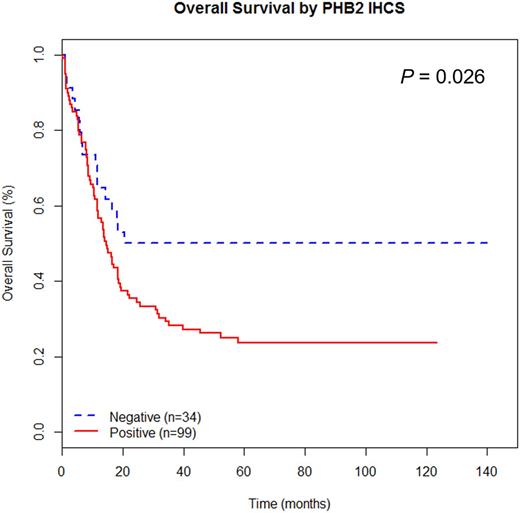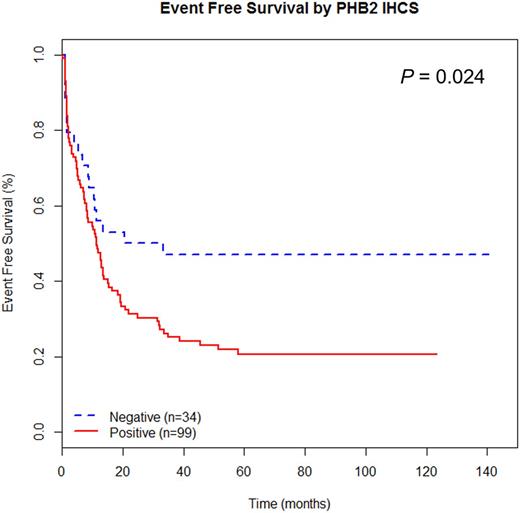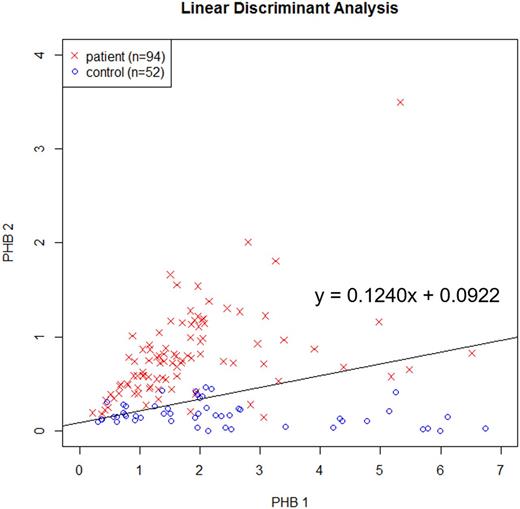Abstract
Background: Prohibitin (PHB) is a highly conserved protein, widely expressed in multiple cellular compartments such as mitochondria and nucleus. Recent studies have demonstrated that PHB played an important role in the regulation of mitochondrial function, cell proliferation and development. Our proteome analysis has revealed PHB was highly expressed in primary AML cells compared with normal cells. This finding prompted us to investigate whether PHB could serve as a potential diagnostic, prognostic, and therapeutic target in AML.
Patients and Methods: PHB2 protein expression was assessed in 133 newly diagnosed normal karyotype AML (NK-AML) patients by using immunohistochemical staining (IHCS) on paraffin-embedded bone marrow sections. The degree of PHB2 protein expression was scored as 0-8 as a sum of a diffuseness score (0-5) and an intensity score (0-3). Overall survival (OS) and event-free survival (EFS) was analyzed according to PHB2 expression score. Also, we developed quantitative reverse transcriptase PCR (qRT-PCR) method to measure mRNA expression of PHB1 and PHB2 genes for the optimal algorithms for the discrimination of AML cells from the normal blood or hematopoietic cells.
Because accumulation of beta-catenin in the nucleus has been identified in leukemic cells, we investigated the effect of beta-catenin accumulation on PHB expression. We monitored the expression levels of PHB with lithium chloride treatment, which blocks GSK-3beta activity and ultimately affects beta-catenin accumulation.
For the development of anti-leukemic drug candidates targeting PHB in AML cells, we synthesized two potent chemical substances that can alkylate PHB: cyclohexylphenyl-chloroethyl urea (CCEU) and iodophenyl-chloroethyl urea (ICEU). We evaluated their therapeutic effects in the primary AML and AML cell lines.
Results:
In the PHB2 IHCS, using the cutoff as positivity score 4.0, PHB2 positive patients showed inferior OS (23.7% vs 50.0%; P = 0.026) and high hazard ratio (1.808; P = 0.028) compared to PHB2 negative patients (figure 1). Using the same cutoff, PHB2 positive patients showed inferior EFS (20.7% vs 47.1%; P= 0.024) and high hazard ratio (1.795; P = 0.026) (figure 2). In the qRT-PCR assay of PHB1 and PHB2, quantitative expression (ddCt) of PHB1 gene was higher in the control group: 0.31-28.32 (4.40+/-5.80; Mean+/-SD) versus 0.22-6.52 (1.83+/-1.56) in patient group. Meanwhile, PHB2 gene expression was higher in the NK-AML patient group: 0.15-3.49 (0.80+/-0.47) versus 0.00-0.46 (0.16+/-0.13) in control group. Using linear discrimination analysis, we derived a linear equation for discrimination between normal and AML cells. Estimating the prevalence of AML as 57.2/1,000,000, the sensitivity of newly developed algorithm was 93.6%, specificity was 76.9%, negative predictive value was 99.9%, and positive predictive value was 2.28% (figure 3).
PHB protein expression was increased by inhibition of the MAPK pathway and decreased by activation of EGF signal. We identified the TCF-4/LEF-1 binding motif, CATCTG, in the promoter region of PHB by site-directed mutagenesis and ChIP assay. This beta-catenin-mediated activation of PHB expression was independent of c-MYC activation, a product of Wnt signaling. These data indicated that PHB was a direct target of beta-catenin and the increased level of PHB in leukemic cells can be regulated by Wnt signaling.
Using CCEU and ICEU, time and dose dependent manner of proliferation suppression was observed in primary AML and AML cell lines. Notable morphological transformation of AML cells was observed when treated with 10-100 umol of CCEU and ICEU for 24 hours. The half maximal inhibitory concentration (IC50) was 25 umol for most AML cells.
Conclusions:
Overexpression of PHB2 was associated with poor prognosis in NK-AML. Newly developed discrimination algorithm using qRT-PCR showed the possibility as a rapid diagnostic tool for leukemic cell identification. Our functional study suggested that the elevated level of PHB in leukemic cells was the result of Wnt signals which were up-regulated in AML cells. Finally, this study developed novel alkylating chemotherapeutics targeting PHB for selective killing of leukemic cells. PHB2 expression status can provide clinically valuable information for the diagnosis, prediction of the prognosis, detection of minimal residual disease, and therapeutic targeting of NK-AML.
No relevant conflicts of interest to declare.
Author notes
Asterisk with author names denotes non-ASH members.




